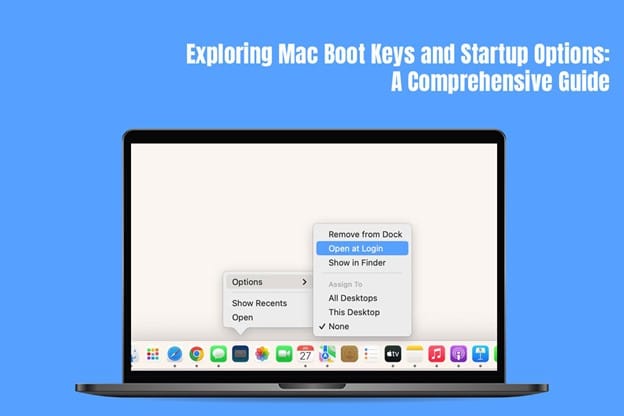Did you know that the boot process of Mac devices is more than turning it on and waiting for the desktop to appear? Beneath the surface and hidden from sight lies a robust set of tools and options that are only accessible through specific key combinations. In this comprehensive guide, you will learn of the fascinating world of Mac boot keys and how you can access them to troubleshoot simple to complex problems.
Learning the Different Boot Keys
On Intel-based Mac computers, the boot keys are as follows:
- Command + R: This triggers Recovery mode, which is a built-in environment for reinstalling macOS, troubleshooting, or accessing Disk Utility.
- Shift: You can enter Safe mode if you press this key during startup.
- Option: Pressing and holding this key during startup displays the Startup Disk Manager. This enables users to select which disk they want their computer to boot from – whether installation media or an external drive.
- Option + Command + P + R: This key combination resets the PRAM/NVRAM. This stores low-level settings like display resolution and volume. So, if you are facing issues with a startup or experiencing unexpected behavior, this can be helpful.
- Option + Command + Shift + Escape: This key combination force quits applications that are frozen or unresponsive.
On Apple Silicon Macs, the startup options or boot keys are:
- Power button: The Startup Options screen is displayed if you hold the Power button for a few seconds. Here, you can select whether you want to boost from different disks, use the different troubleshooting tools, or enter Recovery Mode.
- Option: As you hold this key during startup, it displays the Startup Options screen.
Now that you know the different keys and buttons you can use to boot and troubleshoot your computer, let’s learn in detail about the different boot modes. Read about Techno Thriller Definition now.
Understanding Boot Modes on Mac
Mac computers offer different boot modes that are designed for specific purposes. The boot modes offer control and flexibility over your system’s startup process. An overview of the different boot modes and their significance are given below.
Boot modes on Intel-based Macs:
- Normal boot mode: As the default boot mode, your computer will start up with all the loaded extensions and features as soon as you press the power button.
- Recovery mode: To boot your Mac in Recovery mode, you have to press Command + R. As you start Mac in Recovery mode, you get access to different tools to restore your system from a Time Machine backup, reinstall macOS, access Terminal or repair your disk using Disk Utility.
- Safe mode: As you launch a Mac in Safe mode, it disables all the non-essential extensions and features. This enables you to diagnose software conflicts and troubleshoot startup issues.
- Target disk mode: You can put your device into this mode by pressing T during startup. This allows your machine to appear as an external drive to another computer, enabling troubleshooting and data transfer.
- Verbose mode: During startup, hold the Command + V keys to enter the Verbose mode. This mode displays text information about the device’s startup process in detail. This information can be helpful in identifying specific problems during startup.
Recovery Mode
On Apple Silicon Macs, you can boot your system into Recovery mode or follow the standard boot procedure. If you press the power button for a few seconds or hold the Option key during startup, you can choose from different startup options that will come up on your screen.
There are also additional boot modes that are worth considering:
- Resetting PRAM/NVRAM: When you hold the key combination mentioned above for resetting PRAM/NVRAM, you get to reset various settings like display resolution, volume, and startup disk selection. So, if you are facing startup problems or experiencing unexpected behavior, things can go back to normal if you reset PRAm/NVRAM.
- Resetting SMC: Resetting SMC means you can restore various hardware functions like battery, fans, and power. Hardware-related issues are solved with this, and you have to perform the reset on startup.
How do you Choose the Right Boot Mode?
The right boot mode depends on your specific needs:
- When it comes to troubleshooting issues related to startup or software conflicts, you can use Safe mode or Recovery mode. You can also use Verbose mode to get detailed information on startup.
- Target Disk Mode can be used when you need to troubleshoot or transfer data using another computer. If you need to correct hardware or software problems, you can reset SMC or PRAM/NVRAM.
No matter what boot mode you use to resolve problems with your Mac, you must remember to regularly back up your Mac. This is essential because boot modes may sometimes erase or modify your data. If you need further assistance, do not hesitate to contact Apple Support.
Do you have anything else to add? Leave a comment.
